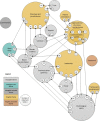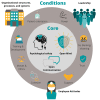Open organisational culture: what does it entail? Healthcare stakeholders reaching consensus by means of a Delphi technique
- PMID: 34521658
- PMCID: PMC8442051
- DOI: 10.1136/bmjopen-2020-045515
Open organisational culture: what does it entail? Healthcare stakeholders reaching consensus by means of a Delphi technique
Abstract
Objectives: Open organisational culture in hospitals is important, yet it remains unclear what it entails other than its referral to 'open communication' in the context of patient safety. This study aims to identify the elements of an open hospital culture.
Methods: In this group consensus study with a Delphi technique, statements were constructed based on the existing patient safety literature and input of 11 healthcare professionals from different backgrounds. A final framework consisting of 36 statements was reviewed on inclusion and exclusion, in multiple rounds by 32 experts and professionals working in healthcare. The feedback was analysed and shared with the panel after the group reached consensus on statements (>70% agreement).
Results: The procedure resulted in 37 statements representing tangible (ie, leadership, organisational structures and processes, communication systems, employee attitudes, training and development, and patient orientation) and intangible themes (ie, psychological safety, open communication, cohesion, power, blame and shame, morals and ethics, and support and trust). The culture themes' teamwork and commitment were not specific for an open culture, contradicting the patient safety literature. Thereby, an open mind was shown to be a novel characteristic.
Conclusions: Open culture entails an open mind-set and attitude of professionals beyond the scope of patient safety in which there is mutual awareness of each other's (un)conscious biases, focus on team relationships and professional well-being and a transparent system with supervisors/leaders being role models and patients being involved. Although it is generally acknowledged that microlevel social processes necessary to enact patient safety deserve more attention, research has largely emphasised system-level structures and processes. This study provides practical enablers for addressing system and microlevel social processes to work towards an open culture in and across teams.
Keywords: change management; health & safety; health policy; human resource management; medical education & training; organisational development.
© Author(s) (or their employer(s)) 2021. Re-use permitted under CC BY-NC. No commercial re-use. See rights and permissions. Published by BMJ.
Conflict of interest statement
Competing interests: None declared.
Figures
References
MeSH terms
LinkOut - more resources
Full Text Sources
Medical
Research Materials



